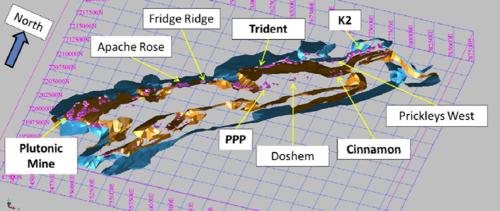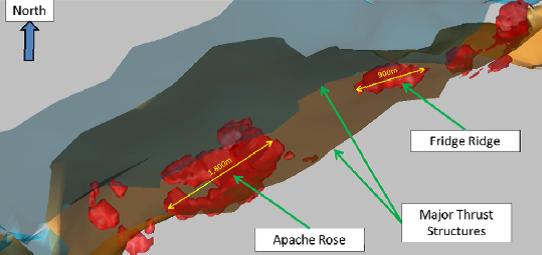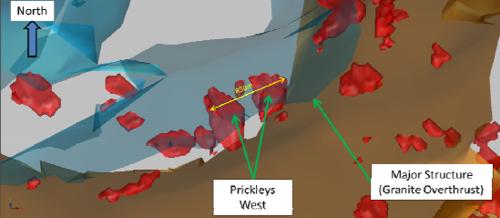WA Marymia 3D Targeting
Marymia 3D Modelling
Kenex was engaged by Dampier Gold to deliver a regional 3D mineral potential map over the prolific but underexplored Plutonic-Marymia Greenstone Belt in central Western Australia. The specific aim was to understand the geology in 3D space, understand 3D controls on gold mineralization, and statistically assess the mineral potential of the region at depth, to allow the objective prioritisation of exploration of the region in the future. The model was designed to integrate all available technical information and develop quantitative estimates of mineral potential in three dimensions. The project results indicate that there is excellent exploration potential along untested portions of the greenstone belt for the discovery of concealed multi-million ounce deposits.

Oblique view of entire Plutonic – Marymia Greenstone belt showing major deposit locations, four priority targets plus numerous other locations of high mineral potential (magenta). Turquoise = granite mafic thrust contacts; brown = mafic/ultramafic – metasediment contacts.
Regional 3D Mineral Potential Map
Kenex, working in close association with Dampier Gold technical staff, delivered a 3D mineral potential map covering the entire Plutonic-Marymia greenstone belt. The map integrated all available geophysical, geological, and geochemical information to assess the mineral potential in three dimensions to a depth of 2.2 km. The 3D mineral potential map predicts where the highest concentrations and/or intensity of known controls on mineralisation are located throughout the entire greenstone belt, which allows the user to focus on specific depth zones, resulting in improved targeted exploration.
Four high priority target zones were highlighted, out of more than 30 identified, namely: Apache Rose, Fridge Ridge, Doshem and Prickleys West have been selected by Dampier for detailed analysis. The high priority target zones are all located at favourable geological positions with potential to host large gold rich mineralised systems.
Apache Rose Target
The largest identified target zone is Apache Rose, which in plan has dimensions of approximately 1,800 m x 900 m and extends vertically to at least 1,000 m depth. Apache Rose exhibits the following attributes making it a high priority target zone:
- Favorable geology for hosting significant mineralised systems comprising multiple stacked shear zone lodes similar to Plutonic or Trident;
- Proximity to two major thrust structures, including the granite overthrust;
- Important east-west intersecting structures detected by geophysics;
- Gold in soil geochemical anomaly at surface;
- No drilling within the 1,800 m strike length of the target;
- Potential for near surface mineralisation.
Fridge Ridge Target
The Fridge Ridge target zone has plan dimensions of approximately 900 m x 250 m and a vertical extent of about 800 m. Shallow RAB drilling by previous explorers (maximum depth of 50 m) at the eastern end of the target zone intersected narrow uneconomic gold mineralisation which it is now thought may indicate the peripheral extent of a significant mineralised system at depth, similar to the undeveloped Trident deposit, located in an equivalent geological position. Fridge Ridge exhibits the following attributes making it a high priority for further detailed evaluation prior to drill testing:
- Favourable host rocks for significant mineralised systems comprising multiple stacked shear zone lodes similar to Plutonic or Trident;
- Proximity to two major thrust structures including the granite overthrust;
- Important east-west intersecting structures detected by geophysics;
- Sub-economic shallow mineralisation intersected in RAB drilling analogous to Trident.

Zoomed in oblique view showing the Apache Rose and Fridge Ridge priority targets (Red) located between two major thrust structures in mafic and ultramafic rocks (translucent turquoise and brown).
Doshem Target
The Doshem target zone has plan dimensions of approximately 900 m x 300 m and a depth extent of more than 500 m. It is also located adjacent to the same major structure interpreted as one of the key controls on the Cinnamon deposit. The following attributes highlight Doshem as a high priority target zone for further detailed evaluation, prior to drill testing:
-
Favourable lithologies for hosting significant mineralised systems, similar to the quartz stockwork style at the nearby Cinnamon deposit;
-
Proximity to an important major structure detected by geophysics;
-
Multi-element geochemical anomaly located over the target;
-
No previous drilling within 900 m of the target zone;
-
Potential for significant near surface mineralisation.

Zoomed in oblique view showing the Doshem priority target (red) located adjacent to the major structure (translucent blue) interpreted to be one of the key controls on the Cinnamon deposit
Prickleys West
The Prickleys West target zone has a surface expression of approximately 850 m x 500 m and extends to a depth of more than 700 m. It is located adjacent to and projects below the same interpreted granite overthrust that hosts the Trident deposit, located to the south-west. Prickleys West exhibits the following attributes:
-
Favourable lithologies for hosting significant quartz vein mineralised systems, similar to the nearby K2 deposit;
-
A major east-west structure detected in geophysics intersects the granite overthrust at Prickleys West;
-
Drilling has intersected near surface mineralisation that may indicate a larger mineralised system at depth, comparable to the Trident deposit;
-
Large untested areas with potential to host plunging high grade shoots.

Zoomed in oblique view showing the Prickleys West priority target (red) located adjacent to and extending below the granite overthrust structure (translucent turquoise).
At the completion of the modelling, aside from the development of drill targets, the understanding of the geology in 3D was enhanced and some of the limitations were better understood. The controls on gold mineralisation that can be used to statistically assess the mineral potential of the region at depth were established, allowing ongoing exploration to be more efficiently targeted. Any additional exploration can also be used to test and refine the geological and structural surfaces, adding to the understanding of the region at every stage.
Learn more about this project
Publications:
